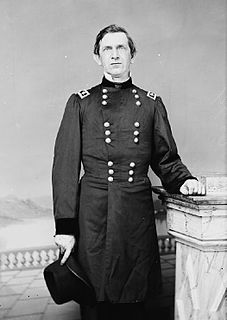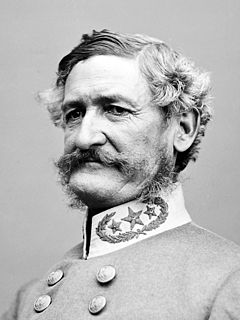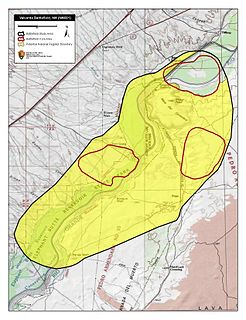
Edward Richard Sprigg Canby was a career United States Army officer and a Union general in the American Civil War.

Arizona Territory, colloquially referred to as Confederate Arizona, was an organized incorporated territory of the Confederate States that existed from August 1, 1861 to May 26, 1865, when the Confederate States Army Trans-Mississippi Department, commanded by General Edmund Kirby Smith, was surrendered at Shreveport, Louisiana. However, after the Battle of Glorieta Pass, the Confederates had to retreat from the territory, and by July 1862, effective Confederate control of the territory had ended. Delegates to the secession convention had voted in March 1861 to secede from the New Mexico Territory and the Union, and seek to join the Confederacy. It consisted of the portion of the New Mexico Territory south of the 34th parallel, including parts of the modern states of New Mexico and Arizona. The capital was Mesilla, along the southern border. The breakaway region overlapped Arizona Territory, established by the Union government in February 1863.

The Battle of Glorieta Pass in the northern New Mexico Territory, was the decisive battle of the New Mexico campaign during the American Civil War. Dubbed the "Gettysburg of the West" by some authors, it was intended as the decisive blow by Confederate forces to break the Union possession of the West along the base of the Rocky Mountains. It was fought at Glorieta Pass in the Sangre de Cristo Mountains in what is now New Mexico, and was an important event in the history of the New Mexico Territory in the American Civil War.

Henry Hopkins Sibley was a career officer in the United States Army, who commanded a Confederate cavalry brigade in the Civil War.

The New Mexico campaign was a military operation of the Trans-Mississippi Theater of the American Civil War from February to April 1862 in which Confederate Brigadier General Henry Hopkins Sibley invaded the northern New Mexico Territory in an attempt to gain control of the Southwest, including the gold fields of Colorado and the ports of California. Historians regard this campaign as the most ambitious Confederate attempt to establish control of the American West and to open an additional theater in the war. It was an important campaign in the war's Trans-Mississippi Theater, and one of the major events in the history of the New Mexico Territory in the American Civil War.

The Battle of Valverde, also known as the Battle of Valverde Ford, was fought from February 20 to 21, 1862, near the town of Val Verde at a ford of the Rio Grande in Union-held New Mexico Territory, in what is today the state of New Mexico. It is considered a major Confederate success in the New Mexico Campaign of the American Civil War, despite the invading force abandoning the field and, eventually, retreating from the territory entirely. The belligerents were Confederate cavalry from Texas and several companies of Arizona militia versus U.S. Army regulars and Union volunteers from northern New Mexico Territory and the Colorado Territory.
The Battle of Peralta was a minor engagement near the end of Confederate General Henry Hopkins Sibley's 1862 New Mexico Campaign.

The Army of New Mexico, also known as the Sibley Brigade, was a small Confederate field army in the American Civil War. It operated in Confederate Arizona and New Mexico Territory during the New Mexico Campaign in late 1861 and early 1862, before it was transferred to Louisiana. At first the force was tasked with securing Confederate Arizona's forts, most of which were still in Union hands. John R. Baylor had already established the Confederate Territory of Arizona after the First Battle of Mesilla in 1861. Now the goal was to capture the remaining U.S. held forts in Confederate Arizona and to invade New Mexico Territory. The army also hoped to capture the mines of Colorado and California, to secure gold and silver supplies to finance the Confederate war effort. Ultimately, the Confederate plans were thwarted at the Battle of Glorieta Pass.

John Potts Slough was an American politician, lawyer, Union general during the American Civil War, and Chief Justice of New Mexico. He commanded the Union forces at the Battle of Glorieta Pass.

Old Town is the historic original town site of Albuquerque, New Mexico, for the provincial kingdom of Santa Fe de Nuevo México, established in 1706 by New Mexico governor Francisco Cuervo y Valdés. It is listed on the New Mexico State Register of Cultural Properties as the Old Albuquerque Historic District, and is protected by a special historic zoning designation by the city. The present-day district contains about ten blocks of historic adobe buildings surrounding Old Town Plaza. On the plaza's north side stands San Felipe de Neri Church, a Spanish colonial church constructed in 1793.
The Trans-Mississippi Theater of the American Civil War consists of the major military operations west of the Mississippi River. The area is often thought of as excluding the states and territories bordering the Pacific Ocean, which formed the Pacific Coast Theater of the American Civil War (1861–1865).
Louisa Hawkins Canby was nicknamed the "Angel of Santa Fe" in 1862 for her compassion toward sick, wounded, and freezing Confederate soldiers at Santa Fe, New Mexico. Mrs. Canby was the wife of Union Brig. Gen. Edward Richard Sprigg Canby whose order to destroy or hide not only weapons and ammunition but all food, equipment, and blankets prior to any retreat was largely responsible for the Confederates' misery. Taking pity on her husband's enemies, Mrs. Canby not only organized other officers' wives to nurse the sick and wounded among the occupying Confederate forces, but also showed Col. William Read Scurry where fleeing Union forces had hidden blankets and food. Mrs. Canby, said one rebel, "captured more hearts of Confederate soldier [sic] than the old general ever captured Confederate bodies."

Manuel Antonio Chaves or Chávez, known as El Leoncito, was a soldier in the Mexican Army and then became a rancher who lived in New Mexico. His life was full of incident, and his courage and marksmanship became literally legendary in his own time. In documented history, as an American soldier he helped win the American Civil War Battle of Glorieta Pass and was in command during an important fight in the Navajo Wars. As a Mexican soldier he probably negotiated the surrender of a large part of the Texan Santa Fe Expedition.

William Read Scurry was a general in the Confederate States Army in the American Civil War.

Arthur Pendleton Bagby Jr. was an American lawyer, editor, and Confederate States Army colonel during the American Civil War. Confederate General E. Kirby Smith, commander of the Trans-Mississippi Department assigned Bagby to duty as a brigadier general on April 13, 1864, to date from March 17, 1864, and as a major general on May 16, 1865. These extra-legal appointments were not made official by appointments of Bagby to general officer grade by Confederate President Jefferson Davis or by confirmation by the Confederate Senate.
Charles Lynn Pyron (1819–1869) was a soldier in the United States Army in the Mexican–American War and a Confederate Army officer in the American Civil War. He fought at the Battle of Monterrey in the Mexican–American War, and during the Civil War fought in the West, including at the battles of Valverde and Glorieta Pass.
James Hobart Ford was a Union colonel and brevet brigadier general during the American Civil War, notable for his contributions in the Trans-Mississippi Theater of the war.
The Department of New Mexico was a department of the United States Army during the mid-19th century. It was created as the 9th Department, a geographical department, in 1848 following the successful conclusion of the Mexican–American War, and renamed Department of New Mexico in 1853. It had to contend with an invading Confederate force during the New Mexico Campaign of the American Civil War from mid-1861 to early 1862, then with Apache tribes during the remainder of the conflict. It was merged into the Department of California after the end of the war as the District of New Mexico.

Union forces entered Tucson on May 20, 1862, with a force of 2,000 men without firing a shot.

William Polk Hardeman was a Confederate States Army brigadier general during the American Civil War. He had fought in the Texas War of Independence in 1836. He was a member of the Texas Rangers and fought in the Mexican-American War in 1846–1847. During the Civil War, he participated in Brigadier General Henry Hopkins Sibley's New Mexico Campaign and in the Red River Campaign. He had a variety of occupations after the war, including superintendent of public buildings and grounds at Austin, Texas.












